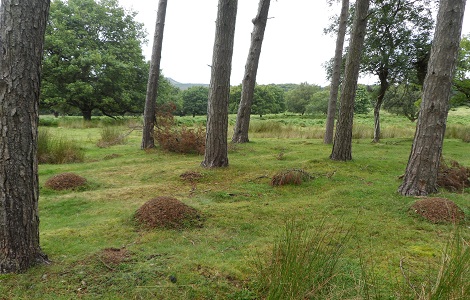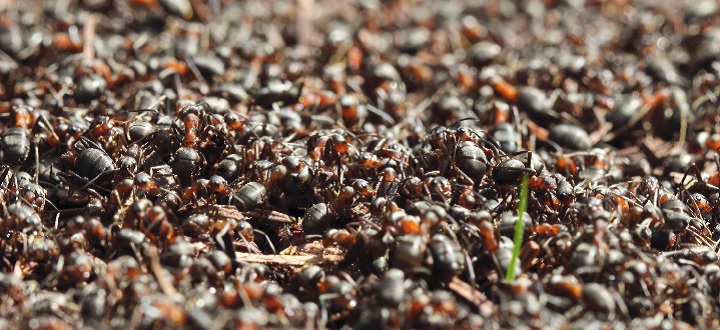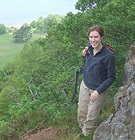Research by our biologists into the UK's largest indigenous ant has shed extraordinary new light on their complex world of mutual aid.
The hairy northern wood ant lives in dome-shape nests – often over two metres high and made of woodland debris like pine needles.
One site can have hundreds or even thousands of nests. But how do they relate to each other?
Dr Elva Robinson, from our Department of Biology, has been working at the National Trust's magnificent Longshaw Estate on the edge of the Peak District, where 1,000 nests have been identified, to probe the fascinating world of ant co-operation.
She wanted to understand how ants divide up their workload, with some individuals foraging while others stay put to defend the nest.
Complex co-operation
“There were hints in the literature that co-operation might be even more complex,” she explained. “So with my team I wanted to use modern tools of network analysis, not available to previous researchers, to unpick what was going on.”
Received wisdom indicated that at best, different nests would mutually tolerate each other.
But the researchers made a startling finding. Ants could be seen moving food between different nests, giving away their hard-won supplies. What could explain this baffling behaviour?
The answer shed entirely new light on the species.
“We could see that successful nests were sending out ants to build other nests, which remained part of one super-network,” said Dr Robinson. “Essentially one colony was occupying multiple sites. The biological term for this is polydomy.
“If an outpost was short of food, supplies were donated by another, better off nest. Roadways were visible running between the nests, created by ants excreting formic acid to burn off vegetation. These routes helped us delineate how many nests were in one network.
“Although anecdotally we knew that the hairy northern wood ant used polydomy, food sharing was an entirely new insight, together with the structure and function of the cooperative networks.”

Ant city: a colony of hairy northern wood ants. Credit: Sam Ellis
Paint-marking revealed that ants stuck to one nest, rather than flitting between locations and they also worked the same roadways, rather than venturing further afield. Additionally, tiny harmless radio transmitters fitted to some ants tracked their interactions and different roles within the colony.
The advantage of this kind of super-network organisation is clear.
“It makes the colony far more resilient to habitat changes,” said Dr Robinson. “If a nest loses a source of food then other ants can step in to donate supplies.
“But the ants are realists. They will stick with a nest for a while, but at some point it may be deemed non-viable, abandoned and another started elsewhere. Ants make mistakes, but they learn the lesson and move on.”
All the ants in these networks are related and share at least some DNA – so in a sense they are a huge extended family. This explains why they altruistically subsume their own interests to the collective. Sterile ants cannot pass on their genes, but they can work to transmit the DNA they share with their queens. Creating multiple nests makes this likelier to happen.
Survival strategy
“It's a fascinating and magnificent survival strategy. It is relevant to note that all the new invasive ant species coming into the UK practice polydomy – it accounts for their success,” Dr Robinson concluded.
If ant organisation wasn’t already impressive enough, research also shows that during cooler, but sunny days, workers will move the brood and queens higher in the nest to benefit from the heat. If it gets too hot they move them lower down in the nest and open ventilation channels.
But intriguingly the northern wood ant has a more self-centred southern cousin that lacks its 'community spirit' and does not create the same kind of co-operative networks.
Understanding what kind of command and control structure ants use to co-ordinate their actions is a key question. After all, one nest probed by the York team in Scotland contained 66,000 individuals – a medium-sized town in human terms.
Further research is needed, but Dr Robinson offers a clue:
“Our work suggests ants don't have the ‘big picture’ and know how much food the colony needs. It seems they are triggered by their own body fat levels and when they get too lean they go out foraging.”
The text of this article is licensed under a Creative Commons Licence. You're free to republish it, as long as you link back to this page and credit us.





